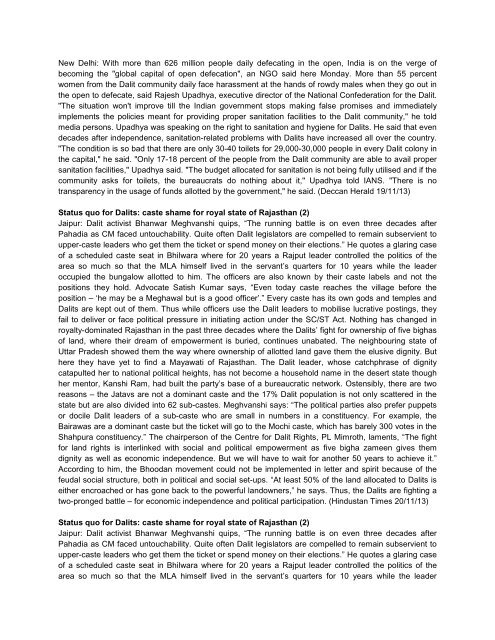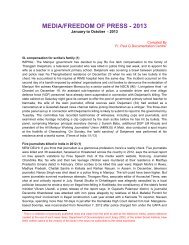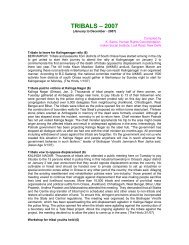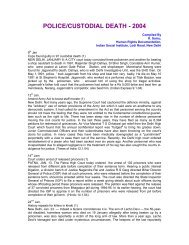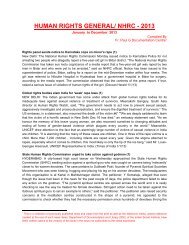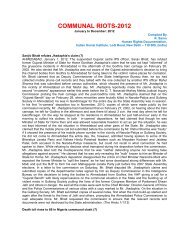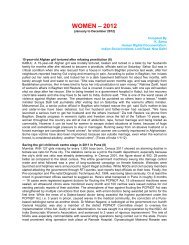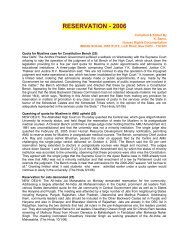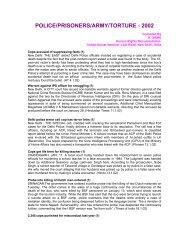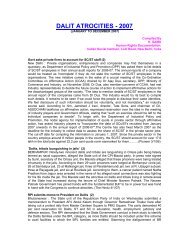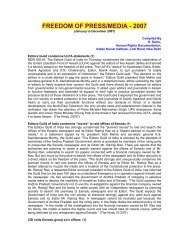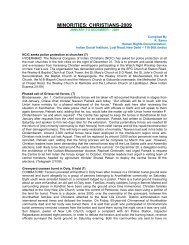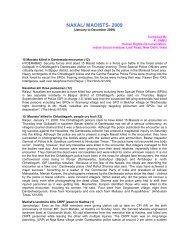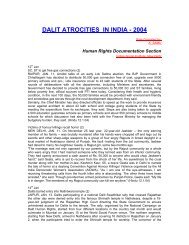INDORE: Dalit discontent with both Congress and BJP in MP is strong and community members feel theabsence of a leader who can make their voice matter in the elections. Dalits and tribals across B RAmbedkar's birth state account for about 35% of total votes. Still, Dalits here feel a sense ofmarginalization — a void no national leader, including Mayawati, has filled . With a population of 2.7 crorein a state of 7.4 crore people, they feel the need of one who can keep them from getting torn betweenBJP and Congress. "Ambedkar's spirit has failed to strike strong roots in MP," says C D Nayak, seniorprofessor at Mhow's Dr Babasaheb Ambedkar National <strong>Institute</strong> of <strong>Social</strong> Science. Nayak says BJP andCongress have minority and SC/ST cells but have little concern for their welfare. Mhow Dalit leaderMohan Bakode says after 66 years of independence, several Dalit areas still have no toilets. Critical ofleaders such as Mayawati, he says: "BSP is no longer the party it was when it started. It is only theeducated Dalit who raises the demand for a leader. MP has no Dalit leaders unlike UP or Maharashtra."(Times of India 15/11/13)Adoption row: Dalits protest against injustice in Mysore (2)Mysore: Guardians of eight year old Ullas and seven year old Anand, who are all set to be given up foradoption to an Italian couple without their consent, protested in front of the Gandhi statue near the courthere on Friday joined by hundreds of Dalit activists and several relatives. Asked why they were againstthe children being adopted, when they seemed willing to go, their uncle Nataraj said, “We may be poor,but we are not heartless enough to let go of our sister’s children altogether. Adoption would end ourrelationship with them and we don’t want that to happen. The children themselves are too small to judgethe situation.” Claiming they had met a child placed in the custody of the Child Welfare Committee,Mysore, who was adopted by a couple in Mandya, but did not like staying with them, he said, “Luckilythe girl was in Mandya and so could come back. We are seeing so much of injustice taking place rightbefore our eyes. Why should we then send our children to Italy?" The protestors urged the Mysoredistrict administration and the CWC, Mysore in a memorandum to immediately remove the children fromthe care of the Vatsalya Charitable Trust in Bengaluru, and put them in a good institution in Mysore inaccordance with former Mysore Deputy Commissioner, Manivannan’s order in 2008. “We would like tosee the children remain safe and well till they complete 18 years of age,” they pleaded. Anand and Ullaswere orphaned five years ago after their mother was gangraped and murdered and their father committedsuicide. The two were put in care of a home in Mysore by CWC but were later shifted to the VCT withouttheir guardian’s knowledge. —S.P. (Asian Age 16/11/13)DSP to probe Dalit girl's rape in Bhiwani school (2)Rohtak: A deputy superintendent of police-level probe has been ordered into the alleged rape of a Class10 Dalit girl at a Bhiwani village. The victim had accused her Sanskrit teacher of sexually assaulting her.Siwani DSP Pritivi Singh said that investigations were on and experts were being roped in to counsel thevictim. As per details, Tosham police had booked a Sanskrit teacher, identified as Shiv Charan, for rape;under the Prevention of Children from Sexual Offences Act and under the SC/ST Act on November 16 onthe complaint of the victim. In her complaint, she said that on November 6, Charan asked her to fetch aglass of water in an isolated room, where he allegedly raped her. The victim stopped going to school fromthe next day without citing any reason to her parents. Later, she narrated the incident to her mother, afterwhich her kin reached the school and manhandled the accused and locked the school. Police said thatthe accused would be arrested after verifying the allegations, as investigations are on. Bhiwani districteducation officer Nirmala Sheoran said that on the demand of villagers, the entire 11-member staff of theschool has been replaced. “The new staff on deputation would take over on Tuesday,” she said.(Hindustan Times 18/11/13)India global capital of open defecation: NGO (2)
New Delhi: With more than 626 million people daily defecating in the open, India is on the verge ofbecoming the "global capital of open defecation", an NGO said here Monday. More than 55 percentwomen from the Dalit community daily face harassment at the hands of rowdy males when they go out inthe open to defecate, said Rajesh Upadhya, executive director of the National Confederation for the Dalit."The situation won't improve till the <strong>Indian</strong> government stops making false promises and immediatelyimplements the policies meant for providing proper sanitation facilities to the Dalit community," he toldmedia persons. Upadhya was speaking on the right to sanitation and hygiene for Dalits. He said that evendecades after independence, sanitation-related problems with Dalits have increased all over the country."The condition is so bad that there are only 30-40 toilets for 29,000-30,000 people in every Dalit colony inthe capital," he said. "Only 17-18 percent of the people from the Dalit community are able to avail propersanitation facilities," Upadhya said. "The budget allocated for sanitation is not being fully utilised and if thecommunity asks for toilets, the bureaucrats do nothing about it," Upadhya told IANS. "There is notransparency in the usage of funds allotted by the government," he said. (Deccan Herald 19/11/13)Status quo for Dalits: caste shame for royal state of Rajasthan (2)Jaipur: Dalit activist Bhanwar Meghvanshi quips, “The running battle is on even three decades afterPahadia as CM faced untouchability. Quite often Dalit legislators are compelled to remain subservient toupper-caste leaders who get them the ticket or spend money on their elections.” He quotes a glaring caseof a scheduled caste seat in Bhilwara where for 20 years a Rajput leader controlled the politics of thearea so much so that the MLA himself lived in the servant’s quarters for 10 years while the leaderoccupied the bungalow allotted to him. The officers are also known by their caste labels and not thepositions they hold. Advocate Satish Kumar says, “Even today caste reaches the village before theposition – ‘he may be a Meghawal but is a good officer’.” Every caste has its own gods and temples andDalits are kept out of them. Thus while officers use the Dalit leaders to mobilise lucrative postings, theyfail to deliver or face political pressure in initiating action under the SC/ST Act. Nothing has changed inroyalty-dominated Rajasthan in the past three decades where the Dalits’ fight for ownership of five bighasof land, where their dream of empowerment is buried, continues unabated. The neighbouring state ofUttar Pradesh showed them the way where ownership of allotted land gave them the elusive dignity. Buthere they have yet to find a Mayawati of Rajasthan. The Dalit leader, whose catchphrase of dignitycatapulted her to national political heights, has not become a household name in the desert state thoughher mentor, Kanshi Ram, had built the party’s base of a bureaucratic network. Ostensibly, there are tworeasons – the Jatavs are not a dominant caste and the 17% Dalit population is not only scattered in thestate but are also divided into 62 sub-castes. Meghvanshi says: “The political parties also prefer puppetsor docile Dalit leaders of a sub-caste who are small in numbers in a constituency. For example, theBairawas are a dominant caste but the ticket will go to the Mochi caste, which has barely 300 votes in theShahpura constituency.” The chairperson of the Centre for Dalit Rights, PL Mimroth, laments, “The fightfor land rights is interlinked with social and political empowerment as five bigha zameen gives themdignity as well as economic independence. But we will have to wait for another 50 years to achieve it.”According to him, the Bhoodan movement could not be implemented in letter and spirit because of thefeudal social structure, both in political and social set-ups. “At least 50% of the land allocated to Dalits iseither encroached or has gone back to the powerful landowners,” he says. Thus, the Dalits are fighting atwo-pronged battle – for economic independence and political participation. (Hindustan Times 20/11/13)Status quo for Dalits: caste shame for royal state of Rajasthan (2)Jaipur: Dalit activist Bhanwar Meghvanshi quips, “The running battle is on even three decades afterPahadia as CM faced untouchability. Quite often Dalit legislators are compelled to remain subservient toupper-caste leaders who get them the ticket or spend money on their elections.” He quotes a glaring caseof a scheduled caste seat in Bhilwara where for 20 years a Rajput leader controlled the politics of thearea so much so that the MLA himself lived in the servant’s quarters for 10 years while the leader
- Page 1 and 2:
DALITS/SCHEDULED CASTES - 2013Janua
- Page 3 and 4:
the bit-piece mythology behind the
- Page 5 and 6:
worst brunt. Only a fraction these
- Page 7 and 8:
old girl was allegedly kicked by th
- Page 9 and 10:
charges. “The accused did not mak
- Page 11 and 12:
and exclude them from other facilit
- Page 13 and 14:
Meanwhile, Dalit activists held agi
- Page 15 and 16:
footing. It was Barla's first publi
- Page 17 and 18:
km from Majure viallge, were eking
- Page 19 and 20:
girl over picking up dung from a fi
- Page 21 and 22:
Debabrata Mohanty reportsUntil a mo
- Page 23 and 24:
Dalit forums push for law giving st
- Page 25 and 26:
heard the accused addressing each o
- Page 27 and 28:
employment generation itself is in
- Page 29 and 30:
implemented properly leaving a larg
- Page 31 and 32: Pioneer that police had recorded th
- Page 33 and 34: Mangalore: The issuance of notices
- Page 35 and 36: order to compensate the loss caused
- Page 37 and 38: gathered at the mini secretariat on
- Page 39 and 40: villages across the state where thi
- Page 41 and 42: declaration given by the victim, Ch
- Page 43 and 44: Man forces dalit boy to carry footw
- Page 45 and 46: The National Crime Records Bureau s
- Page 47 and 48: United Progressive Alliance governm
- Page 49 and 50: Kalam. The activists claimed that t
- Page 51 and 52: the village on a horse," said a res
- Page 53 and 54: Monday night for attacking the yout
- Page 55 and 56: MADURAI: The Madras High Court benc
- Page 57 and 58: the police to deal with any eventua
- Page 59 and 60: had assured officials of cooperatio
- Page 61 and 62: known for his autobiographical nove
- Page 63 and 64: the case of Nathpal Dhilwan, a dali
- Page 65 and 66: about 25km from here, on Monday as
- Page 67 and 68: caste marriages and waning prejudic
- Page 69 and 70: against it. People accompanying the
- Page 71 and 72: New Delhi: In Gujarat’s Mehsana d
- Page 73 and 74: Rathod said. Organizers claim that
- Page 75 and 76: provisions under the SC/ST Act in t
- Page 77 and 78: Castes recently received complaints
- Page 79 and 80: cancellation of the Dalit certifica
- Page 81: Bihar: Dalit girl’s rape, murder
- Page 85 and 86: fish around. Often, young Dalits wo
- Page 87 and 88: (24), in May this year. Fearing ret
- Page 89 and 90: Dinesh Parmar, who had attended the
- Page 91 and 92: country in order to achieve their p
- Page 93 and 94: said Bhardwaj, adding even then the


